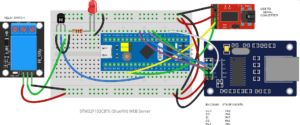Here is the circuit showing how a Web Server on an STM32F103C8T6 can be used to control a Relay Switch:
 The Fritzing code used to create that diagram/image can be downloaded here.
The Fritzing code used to create that diagram/image can be downloaded here.
An ENC28J60 ethernet module is used to connect the STM32F103C8T6 (BluePill) to a network.
Here is the source code for the sketch to load into the STM32F103C8T6 (BluePill):
/*
Web Server
A simple web server that shows the value of the analog input pins.
blinks the built in LED, or toggles a Relay Switch (check the comments)
From: earl@microcontrollerelectronics.com
Also Demonstrates checking the ENC28J60 and keeping it from freezing.
ENC28J60 STM32F103
SCK PA5
SO PA6
SI PA7
CS PA4
RST PA0
VCC - 5V
GND - GND
--ENC28J60--
CLK INT
WOL SO
SI SCK
CS RESET
VCC GND
+-----------------[USB]-----------------+
[SS2|PB12] | [31] [Gnd] |
[SCK2|PB13] | [30] +---+ [Gnd] |
[MISO2|PB14] | [29] +-----+ |0 0| [3V3] |
[MOSI2|PB15] | [28] |Reset| |x x| [Reset] |
[PA8] | [27] +-----+ |1 1| [ 0] | [PB11|SDA2|RX3]
[TX1|PA9] | [26] +---+ [ 1] | [PB10|SCL2|TX3]
[RX1|PA10] | [25] ^ ^ [33] | [PB1]
[USB-|PA11] | [24] Boot1--+ | [ 3] | [PB0|A0]
[USB+|PA12] | [23] Boot0----+ [ 4] | [PA7|A1|MOSI1]
[PA15] | [20] [ 5] | [PA6|A2|MISO1]
[PB3] | [19] +-----------+ [ 6] | [PA5|A3|SCK1]
[PB4] | [18] | STM32F103 | [ 7] | [PA4|A4|SS1]
[PB5] | [17] | Blue Pill | [ 8] | [PA3|A5|RX2]
[SCL1|PB6] | [16] +-----------+ [ 9] | [PA2|A6|TX2]
[SDA1|PB7] | [15] [10] | [PA1|A7]
[PB8] | [32] [11] | [PA0|A8]
[PB9] | [PB9] [12] | [PC15]
| [5V] +---------------+ [13] | [PC14]
| [Gnd] | ST-Link | [14] | [PC13|LED]
| [3V3] |3V3 DIO CLK GND| [Vbat]|
+-------------+---+---+---+-------------+
| | | |
*/
#define BOARD_SPI1_NSS_PIN PA4
#define BOARD_SPI1_SCK_PIN PA5
#define BOARD_SPI1_MISO_PIN PA6
#define BOARD_SPI1_MOSI_PIN PA7
#include <libmaple/iwdg.h>
#include <SPI.h>
#include <UIPEthernet.h>
// ..utility\Enc28J60Network.h file -
//move readReg() subroutine def from private to public
#define NET_ENC28J60_EIR 0x1C
#define NET_ENC28J60_ESTAT 0x1D
#define NET_ENC28J60_ECON1 0x1F
#define NET_ENC28J60_EIR_RXERIF 0x01
#define NET_ENC28J60_ESTAT_BUFFER 0x40
#define NET_ENC28J60_ECON1_RXEN 0x04
#define NET_ENC28J60_CHECK_PERIOD 5000UL
#define iwdg_init_ms(N) iwdg_init(IWDG_PRE_256,((N)/5))
#define pinLED PC13
#define pinSwitch PA15
#define ETH_RS_PIN PA0
byte mac[] = { 0xDE, 0xAD, 0xBE, 0xEF, 0xFE, 0xED };
IPAddress ipdns(192, 168, 0, 1);
IPAddress ip(192, 168, 0, 150);
IPAddress gateway(192, 168, 0, 1);
IPAddress subnet(255, 255, 255, 0);
EthernetServer server = EthernetServer(80);
String cdata = "";
unsigned long timer;
void setup() {
disableDebugPorts();
Serial.begin(115200);
pinMode(pinLED, OUTPUT);
pinMode(pinSwitch, OUTPUT);
digitalWrite(pinLED,LOW);
digitalWrite(pinSwitch,LOW);
eth_reset();
iwdg_init_ms(4000);
timer = millis();
}
void eth_reset() {
pinMode(ETH_RS_PIN, OUTPUT);
digitalWrite(ETH_RS_PIN, LOW);
delay(100);
digitalWrite(ETH_RS_PIN, HIGH);
pinMode(ETH_RS_PIN, INPUT);
Ethernet.begin(mac, ip, ipdns, gateway, subnet);
server.begin();
Serial.print(F("WEB server is at "));
Serial.println(Ethernet.localIP());
Serial.print(F("DNS server is at "));
Serial.println(Ethernet.dnsServerIP());
}
void loop() {
iwdg_feed();
Ethernet.maintain();
if ((millis() - timer) > NET_ENC28J60_CHECK_PERIOD) {
// Enc28J60 is Enc28J60Network class that is defined in Enc28J60Network.h
// readReg() subroutine must be moved from private to public members area in utility\Enc28J60Network.h
// ENC28J60 ignore all incoming packets if ECON1.RXEN is not set
uint8_t stateEconRxen = Enc28J60.readReg((uint8_t) NET_ENC28J60_ECON1) & NET_ENC28J60_ECON1_RXEN;
// ESTAT.BUFFER rised on TX or RX error
// I think the test of this register is not necessary - EIR.RXERIF state checking may be enough
uint8_t stateEstatBuffer = Enc28J60.readReg((uint8_t) NET_ENC28J60_ESTAT) & NET_ENC28J60_ESTAT_BUFFER;
// EIR.RXERIF set on RX error
uint8_t stateEirRxerif = Enc28J60.readReg((uint8_t) NET_ENC28J60_EIR) & NET_ENC28J60_EIR_RXERIF;
Serial.println("---REGS---");
Serial.println(stateEconRxen,HEX);
Serial.println(stateEstatBuffer,HEX);
Serial.println(stateEirRxerif,HEX);
if (!stateEconRxen || (stateEstatBuffer && stateEirRxerif)) {
Serial.println ("ENC28J60 reinit");
// Enc28J60.init(netConfig->macAddress);
eth_reset();
}
timer = millis();
}
EthernetClient client = server.available();
if (client) {
Serial.println(F("\n--Client Connected--\n"));
cdata = "";
Serial.println(cdata);
while (client.connected()) {
if (client.available()) {
char c = client.read();
Serial.write(c);
cdata.concat(c);
if (cdata.indexOf("\r\n\r\n") > 0) {
Serial.print(F("Buffer Length: "));
Serial.println(cdata.length());
client.println(F("HTTP/1.1 200 OK"));
client.println(F("Content-Type: text/html"));
client.println(F("Connection: close"));
if(cdata.indexOf("Analog") > 0) client.println(F("Refresh: 5"));
client.println();
client.println(F("<!DOCTYPE HTML>"));
client.println(F("<html>"));
client.println(F("<body>"));
client.println(F("<br><br><center><H1>STM32F103C8T6 WEB Server</H1></center>"));
if ( (cdata.indexOf("LED") > 0) || (cdata.indexOf("led") > 0) ) {
digitalWrite(pinLED,!digitalRead(pinLED));
if (digitalRead(pinLED)) client.println(F("<center><br><br><br><br><H1>LED OFF!</H1></center>"));
else client.println(F("<center><br><br><br><br><H1>LED ON!</H1></center>"));
client.println(F("</body>"));
client.println(F("</html>"));
break;
}
if (cdata.indexOf("switch") > 0) {
digitalWrite(pinSwitch,!digitalRead(pinSwitch));
if (digitalRead(pinSwitch)) client.println(F("<center><br><br><br><br><H1>Switch ON! </H1></center>"));
else client.println(F("<center><br><br><br><br><H1>Switch OFF!</H1></center>"));
client.println(F("</body>"));
client.println(F("</html>"));
break;
}
if(cdata.indexOf("Analog") > 0) {
client.println(F("<table border=1 cellspacing=4 cellpadding=4>"));
client.println(F("<tr><th>Analog</th><th>Value</th></tr>"));
for (int analogChannel = 0; analogChannel < 4; analogChannel++) {
int sensorReading = analogRead(analogChannel);
client.print(F("<tr><td>"));
client.print(analogChannel);
client.print(F("</td><td>"));
client.print(sensorReading);
client.println(F("</td></tr>"));
}
client.println(F("</table>"));
client.println(F("</body>"));
client.println(F("</html>"));
break;
}
client.println(F("<center><br><br><br><br><H1>Unknown Command!</H1></center>"));
client.println(F("</body>"));
client.println(F("</html>"));
break;
}
}
}
client.stop();
Serial.println(F("\n--Client Disconnected--"));
timer = millis();
}
}
This is an updated and enhanced sketch from a previous post on a WEB server using both the BluePill (STM32F103C8T6) and the ENC28J60 module. It seems the UIPEthernet library has changed since then. I had to add these lines to the code to define the correct pin settings:
#define BOARD_SPI1_NSS_PIN PA4 #define BOARD_SPI1_SCK_PIN PA5 #define BOARD_SPI1_MISO_PIN PA6 #define BOARD_SPI1_MOSI_PIN PA7
The source code has the IP address and network settings for the ENC28J60 ethernet module hard coded. Those settings may need changed for use on a different network.
The relay switch can be attached to any number of AC type low current devices and turned ON/OFF by accessing the WEB server. (The relay switch can possibly handle low current DC devices as well). I used a 2N3904 NPN transistor in my circuit to allow the STM32F103CT6 to turn the relay OFF and ON. This circuit also has a red LED to visually show when the relay is ON or OFF.
The WEB server accepts several ‘commands’:
http://192.168.0.150/led
http://192.168.0.150/analog
http://192.168.0.150/switch
‘LED’ toggles the internal LED On/Off, ‘analog’ displays the analog values of the first 4 analog pins and ‘switch’ toggles the relay On/Off. So now you know how a Web Server on an STM32F103C8T6 can be used to control a Relay Switch.

Recent Comments